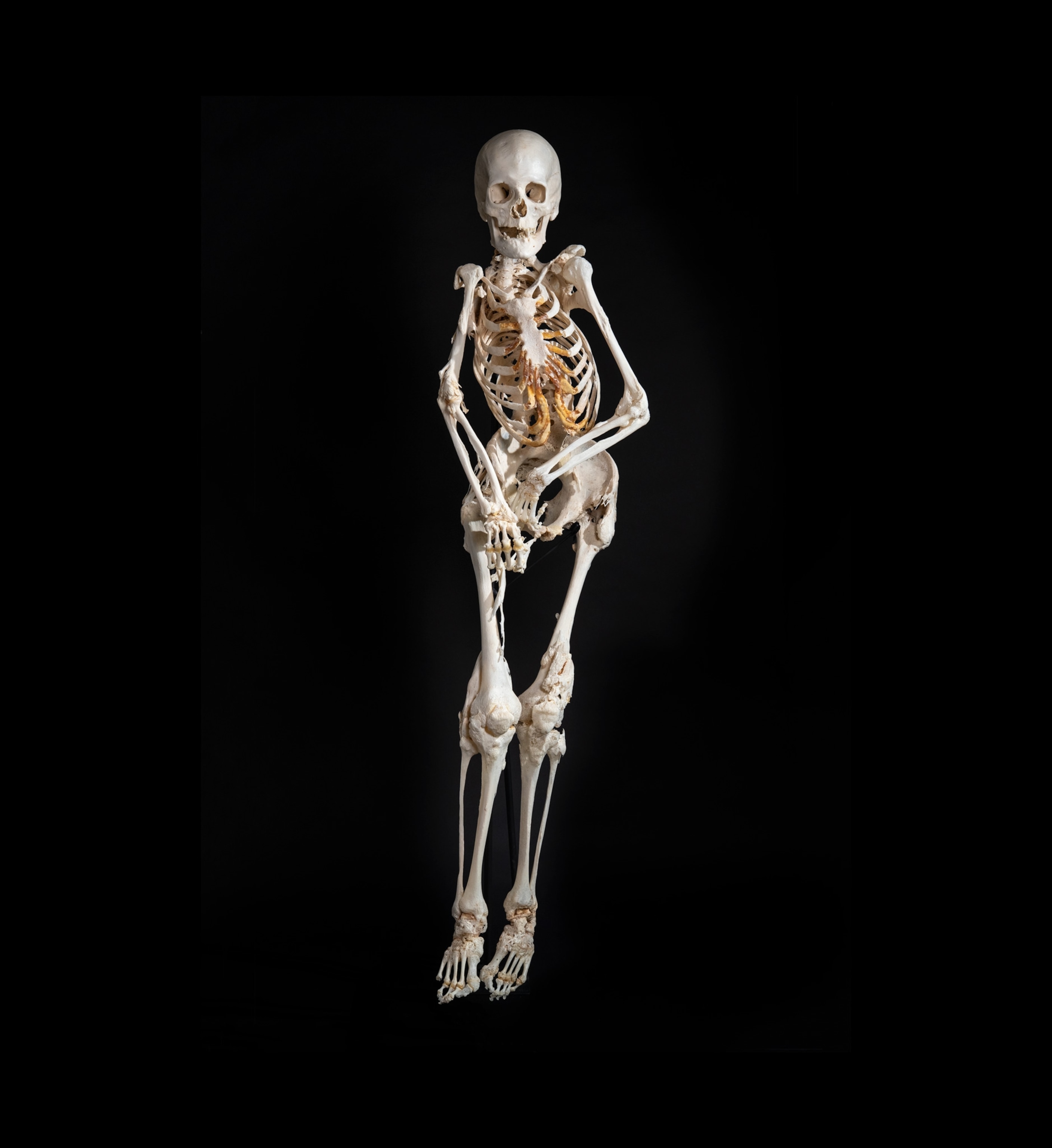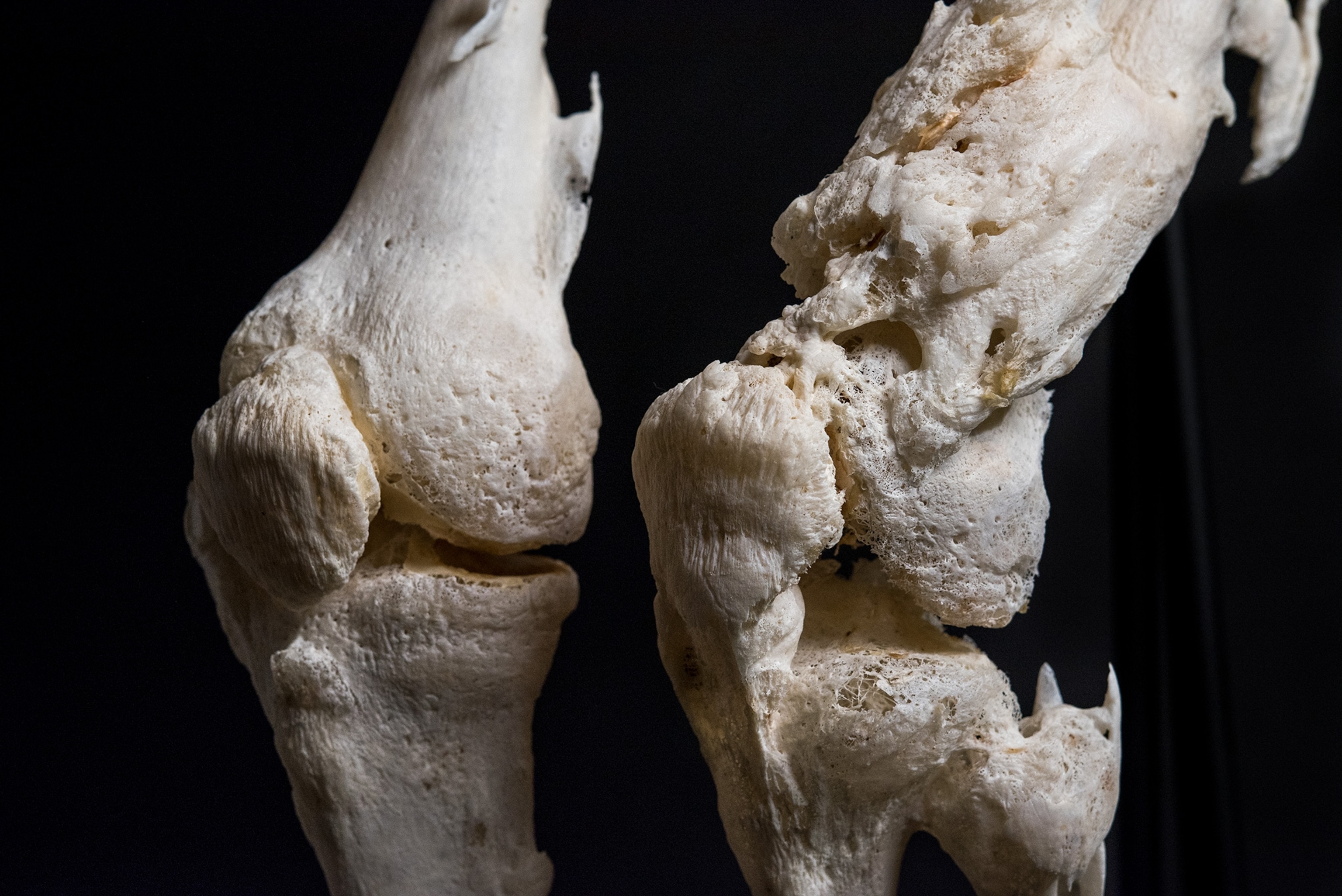
Carol Orzel first saw the double skeleton of Harry Eastlack in 1995, the notable bones standing in a display case at the Mütter Museum of the College of Physicians in Philadelphia. At that moment, she knew she wanted to one day "hang next to Harry.”
More than two decades later, nearing death and only able to move three fingers on her right hand, Orzel stuck to her guns: Her last wish was that her body be donated to the Mütter Museum, where it would educate the public about the rare condition she and Eastlack shared and hopefully help scientists find a cure. (Here’s how you can donate your body to science.)
This week, she got her wish. Orzel, who died in February 2018 at age 58, has now joined Eastlack in the display case at the Mütter Museum.

These two people had one of the rarest diseases on the planet: fibrodysplasia ossificans progressiva (FOP), a genetic disorder that causes soft connective tissues to transform into bone, over time imprisoning its victim in a painful, immobile double skeleton. Only about 900 people have been diagnosed with FOP worldwide.
There’s no cure, but doctors are looking for one. Studying Orzel’s skeleton alongside Eastlack’s will improve our knowledge of not only FOP, but also of more common bone conditions such as osteoporosis. (In some places, digital cadavers are replacing real ones—but should they?)
The science of bone
English surgeon Jon Freke first described FOP in 1740, when he examined a 14-year-old boy who was plagued by large swellings on his spine and ribs. “Joining together in all parts of his back, as the ramifications of coral do, they make, as it were, a fixed bony pair of bodice,” Freke observed.
Today, doctors know that FOP is a neuroinflammatory response often triggered by injury, resulting in overactivity of the bone-forming pathway in stem cells. In 2006, Frederick Kaplan, who heads the division of orthopedic molecular medicine at the University of Pennsylvania’s Perelman School of Medicine, and UPenn geneticist Eileen Shore discovered the cause of FOP: a mutated version of a protein receptor called activin A.
“Patients form sheets, ribbons, and plates of bone that lock across the joints and make movement impossible,” Kaplan says. Sometimes, the disease may even cause a person’s bones to become lighter than average, which seems to be a possibility with Orzel.
“I cannot impress upon you how delicate her skeleton is,” says forensic anthropologist Anna Dhody, a curator at the Mütter Museum. “We kind of think of it like if somebody had taken cotton candy and hardened it slightly.”
Life with FOP is progressively painful and restricted, with hard, jagged points digging into soft tissue and fixing people into one position over time. But people with the disease can still live their lives, especially with help from assistive programs, technology, and caregivers.
Take Orzel, who “lived life fast and furious,” says Dawn Waller, director of the adapted technology program at Inglis House in Philadelphia. This long-term residential care facility for people with physical disabilities is where Orzel called home for 36 years.
She took her wheelchair all around the city, visiting the art museum, shopping for clothes, and drinking wine with friends. She loved bling—earrings, necklaces, bracelets, rings, even tiaras. She amassed a large collection of jewelry, which will be displayed near her skeleton. As an educator and advocate for FOP research, she visited UPenn to speak to incoming classes of medical students, and in 1992, she cut the ribbon at the dedication of the university’s FOP research laboratory.
In the end, though, FOP is fatal. One common cause of death is cardiorespiratory failure, as the heart and lungs eventually can't function within a constrictive armor of bone. The average lifespan for FOP patients is 56 years. For the last three years of her life, Orzel was largely confined to bed, and she died of a related neuromuscular disease.
Three drugs to treat the disease are currently in clinical trial: rapamycin, anti-activin A, and palovarotene. “Each of these drugs works on different parts of the mutant bone-forming pathway,” Kaplan says.
Skeleton crew
Orzel was the first FOP patient Kaplan met, in 1984, and she was an inspiration to research the disease. She was also his patient for 30 years. (Similarly, a woman named Susan Potter donated her body pre-mortem to scientists working on the Visible Human Project.)
When Kaplan saw her skeleton at the museum for the first time, “I felt enormous respect. I knew Carol. She was a very noble and great educator. It was a reverential experience—and a very emotional one.”


Comparing Orzel and Eastlack offered an unprecedented chance to see how one rare condition manifested in two individuals. Eastlack—who informed much of Kaplan’s early research into FOP—was male and died in 1973, just before his 40th birthday, while Orzel was female and lived to be 58. He was tall, and she was short. They were immobilized in different positions before they died. Kaplan immediately spotted unexpected features.
“What I saw in Carol's skeleton, I had never seen before in anybody else's,” he says. “Her entire spine is fused all throughout, from the neck all the way down the tailbone.” Many of her joints had degenerated and fused, even where she had no extra bone. Kaplan says this translates into important clinical information. The assumption had been that patients lose movement due to extra bone formation, but perhaps joint loss contributes as well.
“I wonder, even if we're able to stop the extra bone formation in FOP, will we stop the joint degeneration that occurs?” he says.
Studying FOP can also yield insights into common conditions like osteoporosis, which affects one in three women and one in five men over age 50 worldwide.
“When you're researching about how bone is not supposed to grow, it informs you of how bone is supposed to grow,” Dhody says.
In addition, insights gleaned from Orzel’s skeleton may help with treatments for heterotopic ossification, which frequently occurs in people with a hip replacement—itself a common procedure—and in veterans from Iraq and Afghanistan with central nervous system injuries, often from high-velocity blasts or thermal burns.
“I really wish I could've known her in life,” Dhody says of Orzel. “She just sounds like an amazing person. It's sad that she's passed away, but she hasn't fully passed away, in the sense that her legacy and her wish is going to live on and educate the hundreds of thousands of people that will come through the doors of the museum over the years.”








